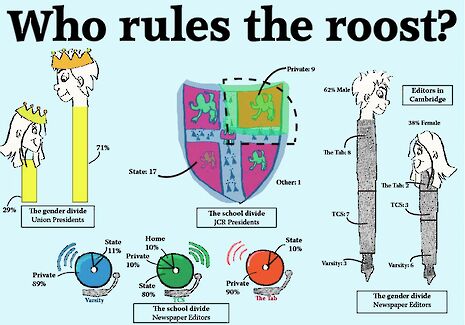Who rules the roost?
Varsity investigates where the people who pull the strings in Cambridge got their head start from

A Varsity investigation has revealed surprising patterns in the demographics of students obtaining positions of influence in university life. Looking at the backgrounds and genders of presidents of the Cambridge Union Society, JCR presidents and editors of the three student newspapers, Varsity found significant disparities between organisations.
To account for movement between schools, particularly at the age of 16, the establishments where students obtained their A-levels (or equivalent qualifications) were taken.
For organisations in which positions change every term, newspapers and the Union, data since and including Michaelmas 2012 was used. For JCRs, whose committees change yearly, we looked at current presidents.
The dividing line in the findings would seem to be between positions that are elected, and those that are appointed. Privately-educated students dominate the non-elected positions. This is most apparent in the cases of the student newspapers. Since Michaelmas 2012, there has only been one state-educated editor-in-chief at Varsity and one at the Tab. TCS is a notable exception to this trend: 80 per cent of editors-in-chief have been from state school backgrounds in the same time period.
Alice Udale-Smith, former editor of Varsity, believes that the issue arises at the application, rather than the selection stage. “I suspect it’s because [fewer] state school pupils apply to be Varsity Editor in the first place,” she said, “rather than because of a particular bias amongst the interviewing committee.”
Udale-Smith also noted the importance of early involvement: “I think sometimes pupils from private schools come to Cambridge with more of an idea of what extra-curriculars are on offer, so don’t find it as daunting to start joining things from the very start of their first year”.
Ashley Chhibber, a former TCS editor, wonders “if it might be a reflection of a wider ‘culture’ [not] just the higher levels, whereby TCS or the Tab attracts ‘a certain type of person’ (even at the level of writers and readers).”
He also notes that “in comparison to JCRs or the Union, student journalism lacks the sort of wide appeal which engages people from completely different backgrounds and interests,” and so it is not surprising that editors tend to be drawn from similar backgrounds.
CUSU’s Access Officer, Helena Blair, found the results “striking”. “They help highlight how access issues are not left behind upon entry into the university, but need addressing once students are here studying at and experiencing Cambridge too.”
Elected positions in Cambridge are more representative of the backgrounds of the wider student body. Of the last seven elected presidents (going back to Michaelmas 2012) of the Cambridge Union Society, three have been from privately-educated backgrounds; a proportion of 43 per cent.
If this is compared to the general admissions statistics for the university over the same period, we see a largely similar distribution. The 2013 admissions cycle saw a split of 61.4 per cent state school students and 38.6 per cent private school students.
Tim Squirrell, the current President of the Cambridge Union Society, said that he was “a little surprised that the state school percentage is that high,” because the election process may favour candidates with “well-established social networks in Cambridge that come more easily to those who went to Oxbridge feeder schools.”
Similarly, in the case of JCR presidents, who are elected by the undergraduate members of their colleges, state school students dominate. Of the 29 undergraduate colleges, 17 JCRs are currently headed up by presidents who went to state schools (data was not available for two colleges).
There is also a gender disparity amongst the people who influence student life. Of all the positions surveyed, 62 per cent were held by men. In the 2013 admissions cycle, less than half of the intake was male.
At The Tab, there have been only two female editors since Michaelmas 2012, and only three at TCS. Conversely, at Varsity, there have been six female and only three male editors during that same period.
Of the 29 JCRs surveyed, only 11 are currently headed by female presidents: Christ’s, Churchill, Clare, Downing, Murray Edwards, Newnham, Queens’, St. Catharine’s, Trinity Hall, Wolfson and Lucy Cavendish. Three of those JCRs, Murray Edwards, Newnham and Lucy Cavendish are female-only and so are inevitably led by female students.
“The JCR presidents’ (lack of) gender balance, it isn’t fantastic,” said Danny McGrath, President of Jesus JCR. “[B]ut we are doing a bit better than our esteemed leaders in the Commons, where just 23 per cent of MPs are female,” he noted.
At the Cambridge Union Society, only two out of seven of presidents have been women in the past three years. Neither of these women were state educated.
Of the 65 Cambridge students for whom school information was available, only nine of them are both female and went to a state school, a proportion of 14 per cent.
Bethan Kitchen, head of the Women, Class, Access branch of CUSU’s Women’s Campaign, criticised the fact that the wide range of people from different backgrounds across the university is “not reflected in the statistics of influential positions.”
However, she also added that “perhaps in looking at the statistics we should remember that the university was not originally designed for females, and has always disproportionately been host to the privately educated.”
Our full results can be found online. Data compiled by Joe Whitwell, Morwenna Jones and James Sutton.
The full results:
For newspaper editors and Cambridge Union Presidents, data is since and including Michaelmas 2012. For JCR Presidents, the data reflects the current presidents.
Varsity Editors-in-Chief
1 State-educated
8 Privately-educated
3 Male
6 Female
Tab Editors-in-Chief
1 State-educated
9 Privately-educated
8 Male
2 Female
TCS Editors-in-Chief
8 State-educated
1 Privately-educated
1 Home-schooled
7 Male
3 Female
Cambridge Union Society Presidents
3 State-educated
3 Privately-educated
1 Other
5 Male
2 Female
JCR Presidents
17 State-educated
9 Privately-educated
1 Other
(2 JCR Presidents did not respond to requests for information)
18 Male
11 Female
Comment: Cambridge can do better
 News / Uni redundancy consultation ‘falls short of legal duties’, unions say6 December 2025
News / Uni redundancy consultation ‘falls short of legal duties’, unions say6 December 2025 News / Cambridge students accused of ‘gleeful’ racist hate crime4 December 2025
News / Cambridge students accused of ‘gleeful’ racist hate crime4 December 2025 News / Researchers find five stages of brain development5 December 2025
News / Researchers find five stages of brain development5 December 2025 Music / The trials and tribulations of indie collabs 6 December 2025
Music / The trials and tribulations of indie collabs 6 December 2025 News / Cambridge cosies up to Reform UK30 November 2025
News / Cambridge cosies up to Reform UK30 November 2025








